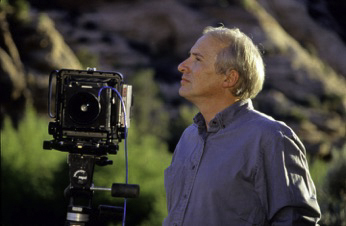Some information may be outdated.
The gallery on Main Street will close at the end of November

Tom Till first visited the Southwest during a college break in the 1970s. He and a few friends were hiking in the Grand Canyon when something magical happened: sunlight caught the rim of the canyon, just as a storm was rolling in. The opposing light—the sun and the storm—made the rim glow, something that Till had never seen before.
“I thought, this is really unbelievable,” Till said. His college was in the Midwest, where he grew up; as his friends drove back to school through Moab, Till thought, what if I could live where the light is this beautiful all the time?
Back then, Till played in a rock and roll band every weekend. He spent his savings from playing music—he played in high school, too—on moving to Moab. In 1977, he bought a camera: a large format 4×5 film camera capable of capturing wide landscapes.
That was also the year he founded Tom Till Photography, though the Tom Till Gallery on Main Street wouldn’t open until 1998. Now, after a nearly 50-year photography career, Till is retiring. The gallery will permanently close at the end of November.

His career spans multitudes. He’s published books, worked for magazines and newspapers, sold thousands of prints, traveled across the world, helped support environmental causes (like in 1985, when his images helped to halt the consideration of a nuclear waste dump near Canyonlands National Park). His retirement, he said, will finally give him time to be at home: he’s spent so much of his life traveling that he’s looking forward to going on simple hikes around Moab. Maybe even without his camera.
“I made all kinds of mistakes at the beginning,” Till said. “I wanted to make a living out of it: I tried a lot of times to make work that seemed to please people, so I noticed the pieces that people liked and I kind of copied myself over and over, thousands of times.”
But he was always trying to do something new, he said. He found inspiration everywhere—at the height of his career, he said, he was constantly thinking about, slightly obsessively, new shots. Sometimes a frame he envisioned in his head would take years to actually capture in the field, he said.

Till took inspiration from his landscape photography heroes, too, some of whom would also become his friends. Till was very close with John Fielder, an American landscape photographer, conservationist, nature writer, and book publisher; his recent death, Till said, has had a very strong effect on him. Nearly half of the books Till has published (30) were published by Fielder.
In 1980, Till’s career really took off. An image he captured of the Chocolate Drops in Canyonlands National Park appeared in the Utah Travel Council calendar: his images would appear in the calendar every subsequent year until 2015. He started traveling across the U.S. capturing images, then across the globe—by 2007, he had visited Australia 14 times.
The other big milestone in his career occurred in 2003, when Till was asked to capture aerial photographs of the Moab uranium tailings area to show to Congress: his photos, which showed how close the uranium tailings were to the Colorado River, helped gain funding for what would become the U.S. Department of Energy’s Uranium Mill Tailings Remedial Action Project (UMTRA).
“I always felt that you have to love your subject to capture it right,” Till said. “I love this subject that I’m shooting. And when you love your subject, you want to save it and preserve it.”
Opening the gallery, he said, was his way of making his work more personal: rather than publishing images only for publications, he could display the photos he enjoyed.
“I am just saying, ‘I love this thing, so I’m going to try to show it to you in the best way that I can, in the best light, at the best time of year, so that you love it too,’” Till said.
Appreciate the coverage? Help keep local news alive.
Chip in to support the Moab Sun News.




